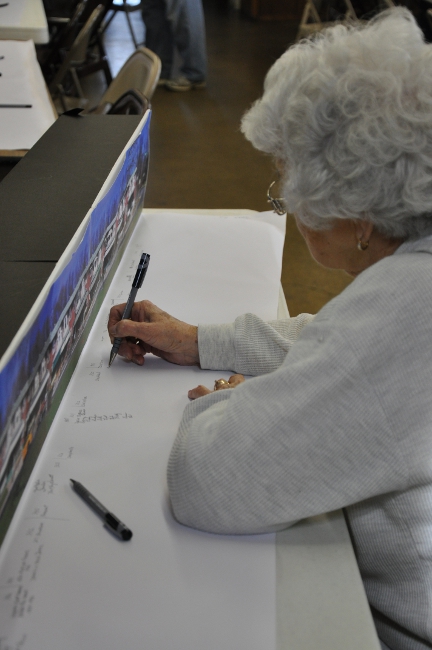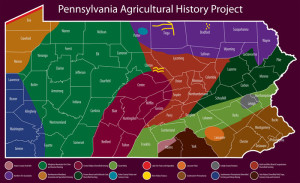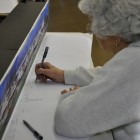Peirce Lewis, an American geographer and emeritus professor at the Pennsylvania State University, may have best described the concept of cultural landscapes; “The human landscape is our unwitting autobiography, reflecting our tastes, our values, our aspirations, and even our fears in tangible, visible form.” Land shows both individual and collective beliefs in a physical manifestation. Most of us can physically see what we do to our land. However, stories associated with the “how” and the “why” we do these things are part of the cultural landscape because they support associated trends, events, and individuals. This is important to state, and restate, because we forget about the depth of information caught-up in the unseen value system that drives the building of communities and use of resources.
Pennsylvania Agricultural History Project
Studying landscape pattern is valuable to managing resources because resources do not respond to municipal, township, city, county, and state boundaries. Increasingly, organizations and governments realize that managing a landscape, or region, is more efficient and successful than managing small-scaled sites. In 1992, the UNESCO World Heritage Committee created “the first international legal instrument to recognize and protect cultural landscapes…” and defined cultural landscapes as having “…a diversity of manifestations of the interaction between humankind and its natural environment”. Also in 1992, the Secretary of the Interior’s Standards were revised to include all historic resources included in the National Register of Historic Places – buildings, structures, sites, objects, districts, and landscapes. Guidelines for the Treatment of Cultural Landscapes were developed and Brief 36: Protecting Cultural Landscapes: Planning, Treatment and Management of Historic Landscapes were published in 1994.
The National Park Service recognizes four types of cultural landscapes and each is eligible for listing on the National Register of Historic Places:
- Historic sites – a landscape significant for its association with a historic event, activity or person. Examples include battlefields and presidential homes and properties.
- Historic designed landscapes – a landscape that was consciously designed or laid out by a landscape architect, master gardener, architect, engineer, or horticulturist according to design principles, or an amateur gardener working in a recognized style or tradition. The landscape may be associated with a significant person, trend, or event in landscape architecture; or illustrate an important development in the theory and practice of landscape architecture. Aesthetic values play a significant role in designed landscapes. Examples include parks, campuses, and estates.
- Historic vernacular landscapes – a landscape that evolved through use by the people whose activities or occupancy shaped it. Through social or cultural attitudes of an individual, a family, or a community, the landscape reflects the physical, biological, and cultural character of everyday lives. Function plays a significant role in vernacular landscapes. This can be a farm complex or a district of historic farmsteads along a river valley. Examples include rural historic districts and agricultural landscapes.
- Ethnographic landscapes – a landscape containing a variety of natural and cultural resources that associated people define as heritage resources. Examples are contemporary settlements, sacred religious sites, and massive geological structures. Small plant communities, animals, subsistence, and ceremonial grounds are often components.
Not only do cultural landscapes provide great support to the relatively small-scale work many of us do, they supply designers, residents, officials, and planners with clues in rediscovering lost knowledge about sustainable communities. Traditional landscapes often reflect sustainable resource-use patterns by showing responses to characteristics and limits of the local natural environment (UNESCO). This information contributes to modern challenges such as farm-to-table food systems, transportation-oriented development, efficient architecture and urban planning, retaining spirit of place, or place making. Long-term traditional forms of land-use support biological diversity in many regions of the world (UNESCO). Perhaps most importantly, cultural landscapes have the potential to acknowledge and validate a community’s right to manage its identity. Here lays an abundance of opportunity for us.
If carefully crafted, the message and process related to cultural landscape identification and management will contribute to achieving many goals of Pennsylvania’s Statewide Historic Preservation Plan. One component essential to achieving this is expansion of community interaction. Through events such as workshops, resident stakeholders participate in identifying and creating cultural landscapes. Such events provide opportunities for the historic management community to expand and strengthen partnerships, engage new audiences, administer the preservation program, and encourage local level preservation planning. If we facilitate this, cultural landscape projects will create fiscal sustainability, long-term participation, easier local government cooperation, and a better public identity for all disciplines involved.
References
UNESCO, Cultural Landscape, History and Terminology )http://whc.unesco.org/en/culturallandscape, accessed April 25, 2013.



My grandfather owned 5 Hudson Ave until his death.
I spent the most enjoyable part of my childhood either on the Terrace, tank hill or down by the RR station. Although I now live in Georgia I still have Middlesworth potato chips ship in.
I have some family pictures that were taken at 5 Hudson Ave if you would like copies. Just let me know how you would like them sent. Pictures of me. My cousin. My dad and uncle in uniform. My grandmother and grandfather.
My grandmother worked for the railroad for a while. I believe she packed bearings.
Ps
My uncle owned I think it was 29 Hudson Ave for a few years in the 70s until his death.